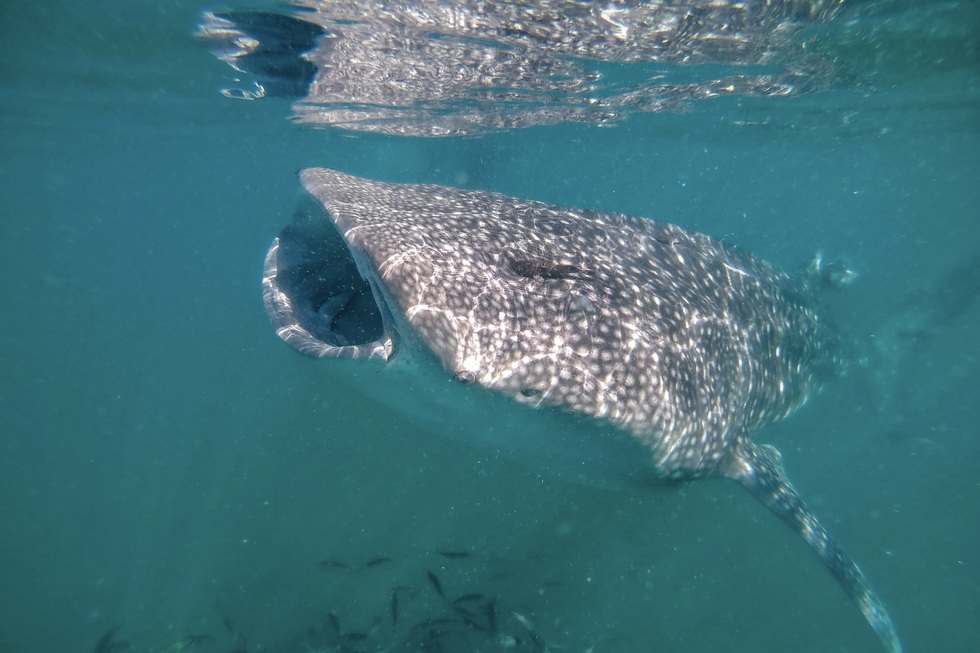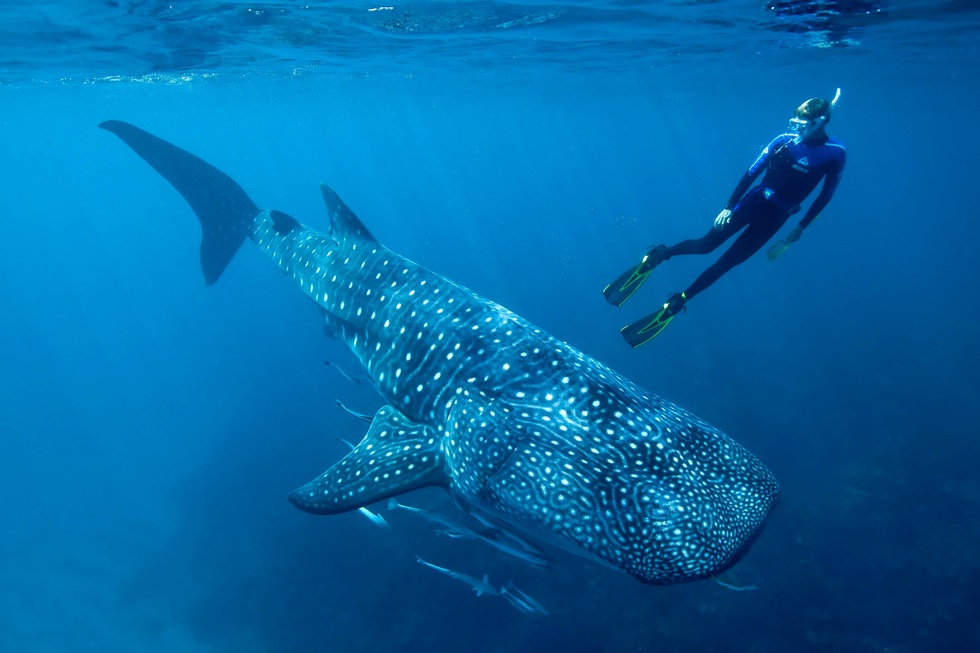7 Places to Swim With Whale Sharks Responsibly
By Rina Baraz NehdarWhen travelers swim with whale sharks, which can be as big as a school bus, their concern need not be for their own safety. Whale sharks are like the cows of the underwater world and have never been known to attack a human.
No, it’s the whale shark, an animal that holds the records for being both the biggest fish and the biggest shark in the world, that has more to worry about. Not long ago, unregulated tourism and the fishing industry almost wiped it out. Now groundbreaking research sites around the world are demystifying these creatures—and providing adventurers opportunities to swim alongside them throughout the year.
The Bay of La Paz, off Baja California, is one of 18 swimmable sites around the world known for its groups of whale sharks. French oceaneer Jacques Cousteau once referred to the Technicolor marine life of this protected pocket of the Sea of Cortez as "the aquarium of the world," but fishermen depleted the ecosystem drastically until 2016, when the International Union for Conservation of Nature (IUCN) officially classified whale sharks, scientifically known as Rhincodon typus, as endangered.
In La Paz, Mexico, visiting whale sharks used to be messy. "You could literally walk on the Malecon [beach boardwalk] and get a whale shark experience for $10," said Dr. James Ketchum, Director of Marine Conservation and co-founder of the conservationist organization Pelagios Kakunjá. Tour operators packed their boats with crowds. There was no talk about respecting the majestic animals, no effort to move boats slowly to avoid damage by propellers, and no attempt to restrict the number of tourists. But in 2017, scientists and locals banded together to stop the recklessness, creating a Whale Shark Refuge. Today, boat operators must fly a flag to indicate that they’ve earned the proper permits through training, and if they break any of the regulations, their flag will be revoked and their operations halted.
While visitors sit patiently on a panga boat waiting for juvenile whale sharks to arrive, naturalist tour guides in the Bay of La Paz drill the rules: Keep six feet between you and the gliding marine creatures, and ten feet from the tail. Be careful, as the animals could change direction at any time. Once in the water, swimmers kick flippered feet this way and that, trying to anticipate the movements of the giant whale shark. The flat-headed fish, lips extending three feet in a food-coma grin, continuously suck in plankton-filled water, oblivious to the commotion.
Only certified guides are allowed to conduct whale shark tours in La Paz, and that requires a diploma, English-language skills, and yearly re-certification. Badillo says sometimes his guests will weep from the experience, and he feels honored to have been a part of that. He especially loves taking little kids into the water because "they can feel all this energy around the whale sharks." Responsible tour operators around La Paz also include Tuna Tours and Baja Adventures.
Not far from the resorts’ overwater bungalows, hundreds of whale sharks call the South Ari Atoll home. They live in the Maldives year-round, "which is very rare," according to Chloe Winn, In-Field Coordinator for the Maldives Whale Shark Research Programme. Most whale sharks are nomadic, sometimes migrating thousands of miles to "follow the food," says Winn. But the conditions in the South Ari Atoll, which is near the Chagos-Laccadive underwater plateau, provide deep and nutrient-rich water.
Whale sharks are typically solitary but come together when tides churn seabeds and reefs, stirring up their favorite meal. Whale sharks need to eat about 45 pounds of plankton daily, so finding groups of them is a good indication of a healthy ecosystem. Winn says the adult whale sharks spend most of their time in open water, while the juveniles often travel to the coast, congregating in plankton-rich hot spots.
Winn says although the Environmental Protection Agency Maldives is working on regulations, they’re not yet in place. "They’re still waiting for rangers," she says, "and sometimes it can be busy." This is one reason why in the Maldives, tour operators must police themselves in areas where management isn’t formally enacted.
Visitors can find responsible tour companies through Lux Safaris, with whom Winn is partnered, as well as TME Retreats, and Boutique Beach. She’s also involved in a campaign called Be Gentle To Giants, which helps ecotourists match with responsible tour companies around the world.
When to go: year-round
There’s still a lot we don’t know about whale sharks. For instance, scientists have never documented them mating, says Winn. "We don’t know where they mate, but we theorize it could take place in St. Helena [Island]. There’s an aggregation there."
Visitors might remember the remote Atlantic island of St. Helena, 1,200 miles from South Africa and 1,800 from South America, as the location of Napoleon’s exile and subsequent death. The island is also the only place in the world that annually attracts a fairly balanced number of adult male and female whale sharks. With a life span ranging 80–130 years, whale sharks don’t reach maturity until they are 25–30 years old, said Winn.
With water temperatures ranging from the mid-60s and 70s Fahrenheit (15–21 Celsius), the waters around St. Helena Island provide a comfortable swimming experience. The government creates guidelines for locals and tour operators (here, scuba diving with them is forbidden but snorkeling is allowed). Responsible tour operators include Enchanted Isle Limited and Dive St. Helena.
When to go: January to May
Scientists estimate that 98% of the whale sharks that pass through the Galápagos Islands are female. So this could be the area where whale sharks give birth, though the only information scientists currently have about their reproductive process was derived from a dead, pregnant whale shark found in 1995 by a Taiwanese fisherman. That specimen carried more than 300 whale shark fetuses at varying degrees of gestation, yet genetic tests determined they all shared the same father. Researchers believe this means whale sharks are able to store sperm and use them selectively—which seems like a convenient talent.
“Whale sharks are ovoviviparous,” Winn explains, “which means the egg is fertilized and hatches inside the female, and then the whale shark is born alive and free-swimming.”
The Galápagos Governing Council carefully controls the movement of visitors on land and sea. The best place to swim or dive with whale sharks is by Darwin and Wolf Islands, which are best reached through live-aboard boat operators like Yūgen Earthside. Scuba divers can take the adventure with scientists and help support conservation efforts.
When to go: July to November
With 300 to 500 whale sharks migrating through its waters annually, Ningaloo Reef, which spans 162 miles on the northwestern Australia coast, is considered to have the largest aggregation on the planet, and consequently, the Ningaloo Coast became a UNESCO World Heritage Site in 2011.
"[Australians] realized very quickly that they didn’t want to kill the goose that laid the golden egg," says Dr. Mark Meekan, Principal Research Scientist for the Australian Institute of Marine Science. So local scientists helped develop the first set of visitor guidelines for whale sharks, and now many other places around the world have adopted similar ones.
Tour operators in Ningaloo have an efficient system for tracking whale sharks: Pilots in planes spot them and radio boat captains. Snorkelers jump into the water near oncoming fish, always respecting numbers and distance, and then get back in the boat to track more.
Meekan says all tour operators around Ningaloo Marine Park can be trusted to be responsible because of the limited number of licenses enforces good practices. Any overnight accommodation in the region can also book you on a tour.
When to go: March to July
Although Meekan has studied whale sharks since 1996, they still surprise him. For years, researchers believed these filter feeders only consumed microscopic sea life and small fish, but it turns out a recent study led by Meekan recently revealed they eat seaweed, too. These record-breaking fish are now also considered the world’s largest omnivores.
Some other mysteries of whale sharks may soon be uncovered around Mafia Island, Zanzibar’s lesser-known neighbor. The Mafia archipelago, southeast of Tanzania’s capital, Dar es Salaam, is made up of five islands—Mafia is the biggest, then there’s Bwejuu, Chole, Jibondo, and Juani. Scientists who have tagged whale sharks and tracked their mobility over the years say the ones around Mafia Island don’t wander too far from the area.
Because the whale sharks observed at Mafia Island are rarely seen elsewhere, researchers can keep better tabs on individuals to identify more precisely the elements that cause them harm. Injuries occur through fishing (due to fishermen trying to catch other targets) and collisions with boats. Some fishermen have also hunted whale sharks for their meat, fins, or oil, which halved their worldwide population within 75 years of the last century.
Although there aren’t enforceable interaction regulations in Mafia Island, Chris Rohner, Principal Scientist at the Marine Megafauna Foundation, said tour operators still try to abide by industry recommendations. "As a guest, you have some power over how the trip goes. Make sure to mention that it is important to you to have a responsible encounter, even if this means missing out on a swim when other people are already swimming with a particular shark," says Rohner. "The best encounters are those where the shark and the tourists are both happy. This is not difficult—whale sharks are really chill and, off Mafia, they are mostly just interested in eating lots of plankton."
Visitors to Tanzania can book trips with leading scientists in whale shark research through the Marine Megafauna Foundation or with responsible tour operator Kitu Kiblu.
When to go: October to February
Regulations are strict around the powder-blue waters of Cancún. So swimming with whale sharks in Cancun or its neighboring islands, Holbox and Isla Mujeres (where the whale shark pictured above was found), should be a stress-free experience for those concerned about their environmental impact. Many boat tours also encounter manta rays, dolphins, and sea turtles on their whale shark swim day.
Rafael de la Parra, Marine Biologist and Executive Director of Ch’ooj Ajauil (Blue Realm), runs responsible whale shark tours through his company Cancun Xtreme. He sees his life work as arming the next generation with enough information to protect these mighty beasts. “The main thing is we need to take care of the ecosystems sustainably around the world. We need to preserve them so the next generation can enjoy them.”
The most important thing a traveler can do is to "choose a sustainable operator," says Winn. "Support local if you can, and support science."
And if you you’re lucky enough to meet a whale shark anywhere in the world, you can upload your photos of it to Wildbook for Whale Sharks, a global database. The animals’ spots and stripes are unique like fingerprints, says Winn, so your encounter can contribute to tracking data. "Hopefully, you can get a match for the individual you spotted—or if it’s a new one, you get to name it."
When to go: May to September













